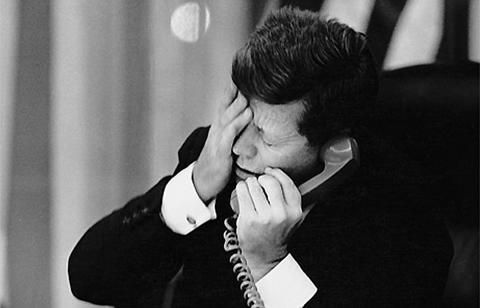-
Table of Contents
- 0. STORY PREFACE
- 1. MISSILES IN CUBA
- 2. OPERATION ANADYR
- 3. OPERATION MONGOOSE
- 4. AMERICA'S FIRST WARNING
- 5. THE KENNEDY BROTHERS
- 6. KENNY O'DONNELL
- 7. THE CUBAN MISSILE CRISIS
- 8. EX COMM and The Crisis
- 9. A CLEAR AND PRESENT DANGER
- 10. THE CRISIS WORSENS
- 11. EYEBALL TO EYEBALL
- 12. BATTLE PLANS
- 13. CLOSE TO THE EDGE
- 14. AN AMERICAN DEATH
- 15. A SECRET DEAL
- 16. THE TRUTH on ENDING the CRISIS
- 17. A DIFFERENT VERSION
- 18. KHRUSHCHEV BLINKS
- 19. THE AFTERMATH
As President Kennedy learned more news about the Soviet build-up of nuclear missiles in Cuba, he became increasingly concerned about its impact on Americans. This image, online via the JFK Library and Museum, depicts the President during the Missile Crisis (in October of 1962).
An American amphibious landing, on the Puerto Rican Island of Vieques, began on October 15th - the day experts at the National Photographic Interpretation Center (NPIC) were examining Major Heyser's U-2 photographs and first noticed a truck convoy approaching a deployment of Soviet missiles near Los Palacios at San Cristobal.
The U.S. military exercise, in Puerto Rico, was code-named "PHIBRIGLEX-62" and involved more than 40 ships, approximately 20,000 naval personnel and 4,000 marines.
At the time, some folks thought the mock invasion was a pretext for another military exercise: the potential blockade of Cuba. Those who thought there was something beyond a mock invasion may have been close to the mark.
By August 23, 1962, the White House had issued "Top Secret & Sensitive" (reproduction "prohibited") National Security Action Memorandum 181. Located at the JFK Library, the document is the first Kennedy Administration memo on the Crisis. It states (among other things):
A study should be made of the advantages and disadvantages of action to liberate Cuba by blockade or invasion or other action beyond MONGOOSE B...
The Kennedy Administration dealt with its first warning of the impending crisis. Action Memo 181 recommends (in point 5) a study of the
...probable military, political and psychological impact of the establishment in Cuba of...surface-to-surface missiles which could reach the U.S.
The President himself dealt with early leaks to the press. Quoted in The New York Times, JFK chastised Senator Kenneth Keating (R-NY) for publicly speaking in the United States Senate regarding the presence of dangerous Soviet missiles in Cuba.
Although the President called Keating "a nut case," it appears the Senator, in fact, knew about the presence of Soviet missiles in Cuba before the President knew. (On the other hand, JFK may have known more himself. A declassified U-2 reconnaissance photograph taken on August 29, 1962 reveals the construction of a surface-to-air [SAM] missile site at La Coloma while an October 5, 1962 CIA chart of "Reconnaissance Objectives in Cuba" lays out "unidentified - missiles.")
Even when the President had more reliable information himself, it was not-yet time to inform the American people of events in Cuba. Not enough specific facts were known.
The President needed more information and he needed to confer with his advisers - especially his closest adviser and younger brother, the U.S. Attorney General Robert F. Kennedy.
-
Table of Contents
- 0. STORY PREFACE
- 1. MISSILES IN CUBA
- 2. OPERATION ANADYR
- 3. OPERATION MONGOOSE
- 4. AMERICA'S FIRST WARNING
- 5. THE KENNEDY BROTHERS
- 6. KENNY O'DONNELL
- 7. THE CUBAN MISSILE CRISIS
- 8. EX COMM and The Crisis
- 9. A CLEAR AND PRESENT DANGER
- 10. THE CRISIS WORSENS
- 11. EYEBALL TO EYEBALL
- 12. BATTLE PLANS
- 13. CLOSE TO THE EDGE
- 14. AN AMERICAN DEATH
- 15. A SECRET DEAL
- 16. THE TRUTH on ENDING the CRISIS
- 17. A DIFFERENT VERSION
- 18. KHRUSHCHEV BLINKS
- 19. THE AFTERMATH


 Back
Back
 Next Chapter
Next Chapter

 Back
Back
 Next Chapter
Next Chapter

